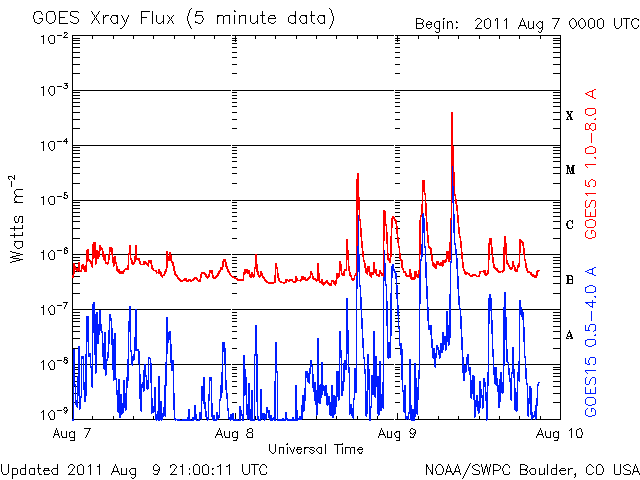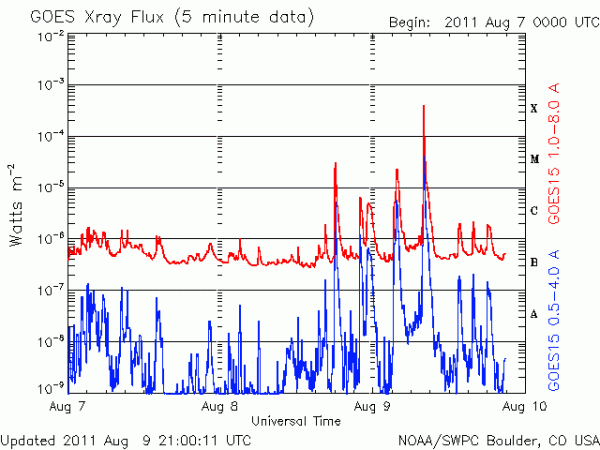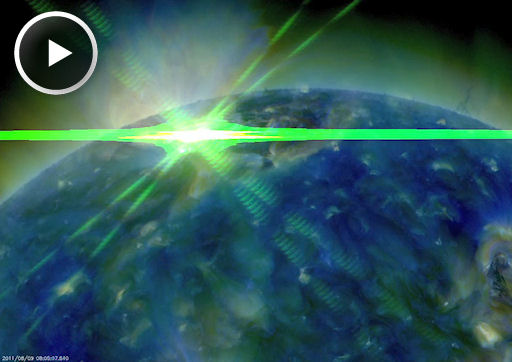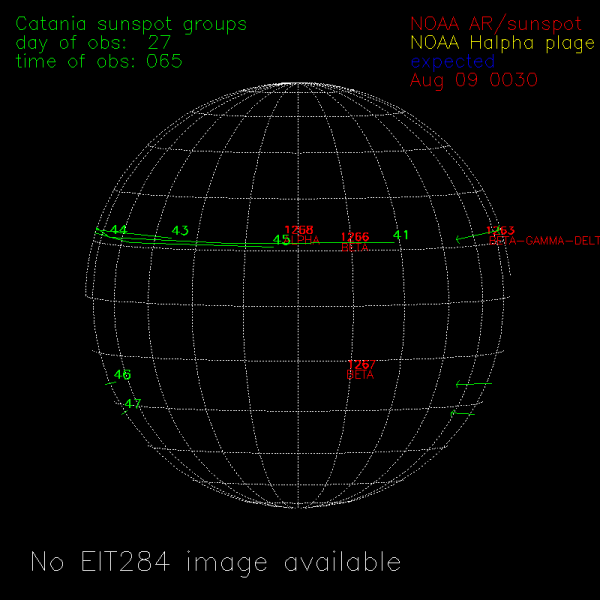Largest flare of Solar Cycle 24 occurred today – Non-Earth directed X6.9

This morning at 08:05 UTC, sunspot 1263 produced an X6.9 solar flare, the third X-flare of new Solar Cycle 24 and the most powerful so far. NASA's Solar Dynamics Observatory captured the explosion's extreme ultraviolet flash:
The brunt of the explosion was not Earth directed. Nevertheless, a minor proton storm is in progress around our planet, which could affect satellites in high-altitude orbits. Also, radiation from flare created waves of ionization in Earth's upper atmosphere, briefly disrupting communications at some VLF and HF radio frequencies.

SOHO coronagraphs show a CME emerging from the blast site. The cloud will probably miss Earth. At this time, however, we cannot rule out a glancing blow from the flank of the CME on or about August 11th. Stay tuned for updates. (SpaceWeather)
This flare had a GOES X-ray magnitude of X6.9, meaning it was more than 3 times larger than the previous largest flare of this solar cycle – the X2.2 that occurred on February 15, 2011. (SDO)
A quick rise in the protons at GOES reached S1 (Minor) levels soon after the eruption. Given the location of the activity, any CMEs would likely be directed away from Earth so no significant Geomagnetic Storm activity is forecast. (SWPC)
The biggest X-class flares are by far the largest explosions in the solar system and are awesome to watch. Loops tens of times the size of Earth leap up off the sun's surface when the sun's magnetic fields cross over each other and reconnect. In the biggest events, this reconnection process can produce as much energy as a billion hydrogen bombs.
If they're directed at Earth, such flares and associated CMEs can create long lasting radiation storms that can harm satellites, communications systems, and even ground-based technologies and power grids. X-class flares on December 5 and December 6, 2006, for example, triggered a CME that interfered with GPS signals being sent to ground-based receivers. (NASA)

Featured image: NOAA SWPC



Thanks Chillymanjaro, very informative. BTW – I meant to type ‘towards’ earth, not ‘toasted’, fat-fingers on an iphone and autocorrect, which ended in a satirical analogy. Think I read somewhere that NASA predicted it to be a max M scale? Will stay tuned, but wondering if there will be internet comms in a few days for a while 🙂
Just got into subject and finding it fascinating. What is the biggest solar flare possible, and what would effects be if directed toasted earth?
the largest solar flare measured with instruments occurred on November 4, 2003. This event saturated the GOES detectors, and because of this its classification is only approximate. Initially, extrapolating the GOES curve, it was pegged at X28. Later analysis of the ionospheric effects suggested increasing this estimate to X45. Solar flares strongly influence the local space weather in the vicinity of the Earth. They can produce streams of highly energetic particles in the solar wind, known as a solar proton event, or “coronal mass ejection” (CME). These particles can impact the Earth’s magnetosphere (see main article at geomagnetic storm), and present radiation hazards to spacecraft, astronauts and cosmonauts. A massive solar flare could knock out electric power for months. Energetic particles in the magnetosphere contribute to the aurora borealis and aurora australis. Energy in the form of hard x-rays can be damaging to spacecraft electronics and are generally the result of large plasma ejection in the upper chromosphere.
The radiation risks posed by coronal mass ejections are a major concern in discussions of a manned mission to Mars, the moon, or other planets. Energetic protons can pass through the human body, causing biochemical damage and hence present a hazard to astronauts during interplanetary travel. This was taken from Wikipedia. We are making A Guide for Solar watchers where we will explain the nature of solar activity and how to read all these diagrams and graphs. It will be available and published on our site soon. Stay tuned!